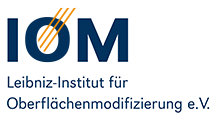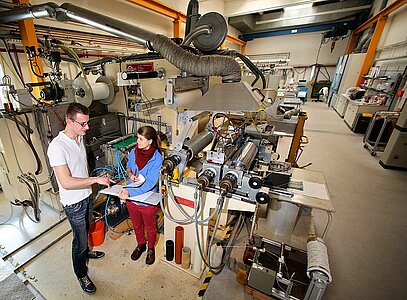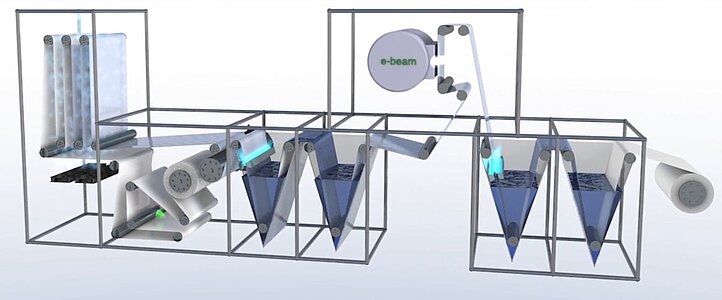Strahleninduzierte Modifizierungsreaktionen
Verschiedene Bestrahlungstechnologien ermöglichen eine gezielte Modifizierung von “Standard”-Polymermembranen, um deren Eigenschaften spezifisch auf individuelle Anforderungen/Applikationen anzupassen. Am IOM stehen dafür zur Verfügung:
- Verschiedene Elektronenbeschleuniger: 160-200 keV, 1-12 MeV
- UV-Bestrahlung: Hg-Lampen, Excimer-Lampen: 308, 283, 172 nm
- Plasma-Behandlung: Niederdruck- und Atmosphärendruck-Plasmen
- Corona-Aktivierung
Damit können eine große Auswahl verschiedener Membranpolymere modifiziert und unterschiedliche resultierende Eigenschaften addressiert werden. Im Fokus stehen dabei permanente (lebenslange) Modifizierungen:
- Materialien: PES, PSf, PVDF, PAN, PA, PE, PET, ...
- Funktionalisierung, Biokompatibilität, Hydrophilierung
- Vernetzung, Stabilisierung von Blends
- Lösungsmittel-/Chlor-Stabilität
Zum Upscaling der Membranmodifizierung stehen ebenfalls Technikumsanlagen zur kontinuierlichen Modifizierung im Rolle-zu-Rolle-Betrieb inkl. Qualitätskontrolle zur Verfügung.
Expertise
- Modifizierung von porösen Polymermembranen im Bereich Nano-, Ultra-, Mikrofiltration (mit/ohne Vlies)
- Modifizierung von Hohlfaser- und Flachfiltermembranen
Umfassende Analytik
Auswahl
- Permeabilität (dead-end, cross-flow)
- Bubble point, MWCO, Siebkurvenanalyse, Hg-Porosimetrie
- Kontaktwinkel, Oberflächenenergie
- Zetapotential, Oberflächenladungsdichte
- Proteinadsorption (BCA Test)
- Fouling (Proteine, Algen, Abwasser, Oberflächenwasser,…)
- Toxizität (Leuchtbakterien)
- Enzymaktivitäten (diverse Enzyme)
- Photokatalytische Aktivität (statische und kontinuierliche Betriebsregime)
- Adsorption von Mikroschadstoffen
- REM, TEM, AFM
- Zugversuch, DMA
- TOC, ICP-OES, SPME-GC/MS
- IR, Raman, UV/VIS
- XPS, XRD, EDX
Highlights
Membranfunktionalisierung im Pilotmaßstab: Rolle-zu-Rolle-Elektronenstrahlsystem mit Inline-Kontaktwinkelbestimmung
A. Schulze, L. Drößler, S. Weiß, M. Went, A. Abdul Latif, D. Breite, K. Fischer
Chem. Ing. Tech. 93 (2021) 1383-1388
https://doi.org/10.1002/cite.202100028To increase the permeation performance and antifouling properties of polymer membranes, a one-step reaction using electron irradiation was developed. This process combines the surface activation of the membrane polymer and the simultaneous permanent immobilization of hydrophilic molecules. This technology can be applied to various polymers, flat sheet/hollow fiber membranes and all pore ranges. The roll-to-roll system developed for this enables all process steps including inline analysis for quality control of the membrane surface in a continuously operated system.
Reagent-Free Immobilization of Industrial Lipases to Develop Lipolytic Membranes with Self-Cleaning Surfaces
M. Schmidt, A. Prager, N. Schönherr, R. Gläser, A. Schulze
Membranes 12 (2022) 599
https://doi.org/10.3390/membranes12060599Biocatalytic membrane reactors combine the highly efficient biotransformation capability of enzymes with the selective filtration performance of membrane filters. Common strategies to immobilize enzymes on polymeric membranes are based on chemical coupling reactions. Still, they are associated with drawbacks such as long reaction times, high costs, and the use of potentially toxic or hazardous reagents. In this study, a reagent-free immobilization method based on electron beam irradiation was investigated, which allows much faster, cleaner, and cheaper fabrication of enzyme membrane reactors. Two industrial lipase enzymes were coupled onto a polyvinylidene fluoride (PVDF) flat sheet membrane to create self-cleaning surfaces. The response surface methodology (RSM) in the design-of-experiments approach was applied to investigate the effects of three numerical factors on enzyme activity, yielding a maximum activity of 823 ± 118 U m−2 (enzyme concentration: 8.4 g L−1, impregnation time: 5 min, irradiation dose: 80 kGy). The lipolytic membranes were used in fouling tests with olive oil (1 g L−1 in 2 mM sodium dodecyl sulfate), resulting in 100% regeneration of filtration performance after 3 h of self-cleaning in an aqueous buffer (pH 8, 37 °C). Reusability with three consecutive cycles demonstrates regeneration of 95%. Comprehensive membrane characterization was performed by determining enzyme kinetic parameters, permeance monitoring, X-ray photoelectron spectroscopy, FTIR spectroscopy, scanning electron microscopy, and zeta potential, as well as water contact angle measurements.
Highly Efficient One-Step Protein Immobilization on Polymer Membranes Supported by Response Surface Methodology
M. Schmidt, A.A. Latif, A. Prager, R. Gläser, A. Schulze
Front. Chem. 9 (2022) 804698
10.3389/fchem.2021.804698Immobilization of proteins by covalent coupling to polymeric materials offers numerous excellent advantages for various applications, however, it is usually limited by coupling strategies, which are often too expensive or complex. In this study, an electron-beam-based process for covalent coupling of the model protein bovine serum albumin (BSA) onto polyvinylidene fluoride (PVDF) flat sheet membranes was investigated. Immobilization can be performed in a clean, fast, and continuous mode of operation without any additional chemicals involved. Using the Design of Experiments (DoE) approach, nine process factors were investigated for their influence on graft yield and homogeneity. The parameters could be reduced to only four highly significant factors: BSA concentration, impregnation method, impregnation time, and electron beam irradiation dose. Subsequently, optimization of the process was performed using the Response Surface Methodology (RSM). A one-step method was developed, resulting in a high BSA grafting yield of 955 mg m-2 and a relative standard deviation of 3.6%. High efficiency was demonstrated by reusing the impregnation solution five times consecutively without reducing the final BSA grafting yield. Comprehensive characterization was conducted by X-ray photoelectron spectroscopy (XPS), Fourier-transform infrared spectroscopy (FTIR), and measurements of zeta potential, contact angle and surface free energy, as well as filtration performance. In addition, mechanical properties and morphology were examined using mercury porosimetry, tensile testing, and scanning electron microscopy (SEM).
Water Softening using Light Responsive Spiropyran Modified Nanofiltration Membrane
R. Das, M. Kuehnert, A. S. Kazemi, Y. Abdi, A. Schulze
Polymers 11 (2019) 344
DOI: 10.3390/polym11020344A novel technique for the covalent attachment of a light-responsive spiropyran onto polyamide thin film composite nanofiltration (NF) membranes in a one-step reaction using low-energy electron beam technology is described. The effect of illumination of the immobilized spiropyran was studied, as well as the resulting membrane properties with respect to MgSO4 retention, water permeability rate, and chlorine resistance. Electron beam irradiation showed a direct effect on the transformation of the rough PA NF membrane surface into a ridge-and-valley structure. Upon UV light irradiation, the spiropyran transformed into zwitterionic merocyanine, which had shown MgSO4 removal of >95% with water permeation rates of 6.5 L/(m2·h·bar). Alternatively, visible light was used to convert merocyanine to spiropyran, which achieved >95% of MgSO4 retention with a water flux of around 5.25 L/(m2·h·bar). The modified NF membranes showed higher chlorine resistance as well as a higher normalized water flux as compared to the reference membrane, without a loss of ion retention. All the NF membranes were characterized by scanning electron microscopy and X-ray photoelectron spectroscopy. This study demonstrates a simple and inexpensive method for the immobilization of molecules onto polymeric membranes, which may be applied in water softening.
Removal of endocrine disrupting chemicals from water through urethane functionalization of microfiltration membranes via electron beam irradiation
Z. Niavarani, D. Breite, M. Yasir, V. Sedlarik, A. Prager, N. Schönherr, B. Abel, R. Gläser, A. Schulze
Front. Environ. Sci. Eng., Vol. 18, 45 (2024)
https://link.springer.com/article/10.1007/s11783-024-1805-6#previewPolyethersulphone (PES) membranes modified with urethane functional groups were prepared through an interfacial reaction using electron beam irradiation. The removal of eight endocrine disrupting chemicals (EDCs) was studied using both pristine and functionalized PES membranes. The prepared membranes underwent characterization using several techniques, including attenuated total reflectance-Fourier transform infrared (ATR-FTIR) spectroscopy, scanning electron microscopy, contact angle analysis, and measurements of pure water flux. Furthermore, dynamic adsorption experiments were conducted to evaluate the adsorption mechanism of the prepared membrane toward the eight EDCs. The urethane functionalized membranes were hydrophilic (52° contact angle) and maintained a high permeate flux (26000 L/h m2 bar) throughout the filtration process. Dynamic adsorption results demonstrated that the introduction of urethane functional groups on the membranes significantly enhanced the removal efficiency of 17β-estradiol, estriol, bisphenol A, estrone, ethinylestradiol, and equilin. The adsorption loading of 17β-estradiol on the functionalized PES membrane was 6.7 ± 0.7 mg/m2, exhibiting a 5-fold increase compared to the unmodified PES membrane. The membranes were successfully regenerated and reused for three adsorption cycles without experiencing any loss of adsorption capacity.


